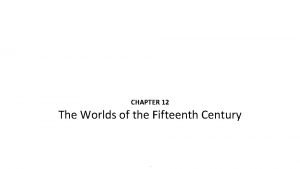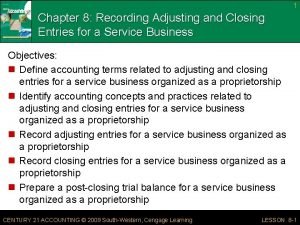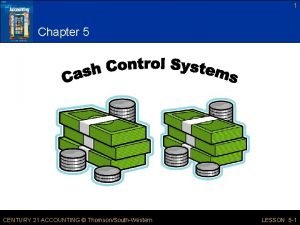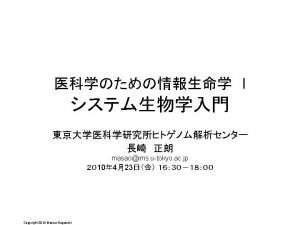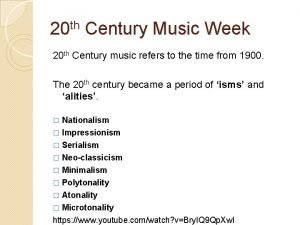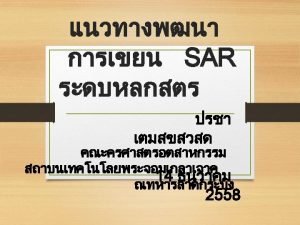Work in the 21 st Century Chapter 12



































- Slides: 35

Work in the 21 st Century Chapter 12 Leadership in Organizations A leader’s job is to motivate (use motivational theories) From traits –> Behaviors -> Contingency -> Traits 1

Module 12. 1: The Concept of Leadership • Conceptual Distinctions Leadership effectiveness vs. Leader emergence • Research indicates that emotional stability, extraversion, openness, & conscientiousness “+” correlated with leader emergence 2

Problem of Defining Leadership Outcomes • Leadership has been variously credited with many different achievements • Problem in choosing which outcome to examine & which time frame to consider • There is typically lag time between actions by a leader & outcomes of those actions 3

Figure 12. 1: Toxic Triangle of Destructive Leadership SOURCE: Padilla et al. (2007) 4

Leader vs. Manager or Supervisor • Leader – Individual in group given task of directing task-relevant group activities or, in absence of designated leader, carries primary responsibility for performing these functions 5

Leader vs. Manager or Supervisor (cont’d) • Attempts at leadership – Attempted leadership – Successful leadership – Effective leadership • Manager or supervisor deals with what is to be done • Leadership deals with how it is to be done 6

Blending of Managerial & Leadership Roles • Leadership previously seen as “icing on the cake” in managers • Modern approaches blend many managerial duties with expectations of what represents effective leadership • Borman & Brush’s taxonomy of managerial performance requirements – Connection b/w leadership & mgmt. very clear 7

Table 12. 1: Areas of Managerial Responsibility 8

Leader Development vs. Leadership Development • Leader development – Develops, maintains, & enhances individual leader attributes (style, personality) • Leadership development (contingency) – Concentrates on leader-follower development – Leadership as social exchange – Interpersonal competence 9

Motivation to Lead • Power motive • Exercise of control over others or environment is pleasing • Activity inhibition • Describes person who is not impulsive • Affiliation need • Need for approval or connections with others • Those with leadership aspirations tend to have high power motive + high activity inhibition + low affiliation needs 10

Motivation to Lead (cont’d) • Motives to lead – Affective-identity → Desire for control – Instrumental → Personal benefits – Social-normative → Duty to lead • Best motivation – (sense of obligation) • Bottom line: There are multiple motivations to lead besides the need for power & control 11

Table 12. 2: Motives to Lead 12

Module 12. 2: Traditional Theories of Leadership • “Great Man” theories (inherent traits) – Life of respected leader examined for clues leading to his/her greatness – Often focused on a galvanizing experience or admirable trait – Tend to be of little value from the perspective of I-O psychology 13

Trait Approach • Prevalent in 1920 s & 1930 s • Attempted to show that leaders possess certain characteristics that non-leaders do not • No consistent relationships between traits & leader effectiveness were found 14

Table 12. 3: Some Characteristics of Leaders that Have Been Studied 15

“Power” Approach • Examines types of power wielded by leaders (French & Raven) • Reward power • Coercive power • Legitimate power • Referent power • Expert power • Very practical in orientation 16

Behavioral Approach Ohio State University studies (Fleishman & Harris ‘ 62) • Behavioral approach • Focused on kinds of behavior engaged in by people in leadership roles • 2 major types of behavior • Consideration • Initiating structure – Represented a leap forward 17

Behavioral Approach University of Michigan studies (R. Likert, ’ 50 s) • Focused more on dynamics of how leaders & groups interacted • Task-oriented behavior – Similar to initiating structure • Relations-oriented behavior – Similar to consideration • Participative behavior • Represented another step forward in leadership research 18

Contingency Approach • Proposed to take into account the role of the situation in the exercise of leadership - think B =f (p*e) • Hersey & Blanchard’s situational theory – Proposed leadership depended in part on maturity of subordinate • Job maturity • Psychological maturity 19

Consequences of Participation: Vroom-Yetton Model • Decision rules regarding participation – Assumes that one of most important duties of leader is to make decisions – Suggests way to choose a decisionmaking strategy – Implication that group decision-making is not always appropriate 20

Module 12. 3: New Approaches to Leadership (Dansereau, Graen, Haga ‘ 75) • Leader-member exchange (LMX) theory – Leaders adopt different behaviors with individual subordinates – In-group members vs. out-group members – Recent revisions describe “life-cycle” of a leader-follower relationship C Squared Studios/Getty Images 21

Transformational Leadership (Burns) • Behavior of inspirational political leaders who transform followers by appealing to nobler motives (MLK Jr. & Gandhi) • 4 general strategies (know them!) – Inspirational motivation – Idealized influence – Intellectual stimulation – Individualized consideration 22

Transformational Leadership (Bass & Avolio) • Bass perceived transformational leadership as building upon transactional leadership in a hierarchy reflecting effectiveness – “Full-range” theory of leadership – FLRM (know them!) 23

Hierarchy of Transformational Leadership Figure 12. 2 Hierarchical Nature of Transformational Leadership Source: Based on Bass (1997). 24

The Charismatic Leader • Charisma – Personal attribute of a leader that hypnotizes followers and compels them to identify with and attempt to emulate the leader 25

Charismatic Leader • Followers are emotionally attached to leader, never question leader’s beliefs or actions, & see themselves as integral to accomplishment of leader’s goal • Acquire some power from situation • Charismatic style may work to keep followers weak Morley/Photo. Link/Getty Images 26

Charismatic Leadership Theory • Approach with many different versions of the notion that charisma is related to leadership; (1) in a crisis situation, followers perceive charismatic characteristics in an individual and accept that person as a leader; (2) certain leader behaviors (use of innovative strategies) contribute to a charismatic aura 27

Module 12. 4: Emerging Topics & Challenges in Leadership Research • Leadership in a changing workplace – Teams/groups – Telecommuting – Temporary workers – Fuzzy boundaries of jobs 28

Male & Female Leaders: Are They Different? • Considerable disagreement among researchers • Women tend to prefer democratic & participative styles; men favor autocratic styles • Men tend to be more assertive; women more extraverted • Women substantially more tender-minded Ryan Mc. Vay/Getty Images 29

Male & Female Leaders (cont’d) • Effect of male- or female-dominated industries on leadership styles – Women in male-dominated industries – Men in female-dominated industries • More research is necessary on gender & leadership 30

Personality & Leadership • One or more Big Five factors appear directly or indirectly in all leadership theories • Big 5 factors emphasize “bright side” of leadership: Effectiveness • Predictors for leader failure more likely to be found in measures of psychopathology 31

Personality & Leadership (cont’d) • Meta-analysis on relationship between personality & leader effectiveness in 3 settings – Characteristics positively associated with leader effectiveness in 3 different environments: Industry Government/Military Student Emotional stability Extraversion Openness to experience Conscientiousness Agreeableness 32

Cross-Cultural Leadership Studies • Global leadership & organizational behavior effectiveness (GLOBE) – (R. House et al. ‘ 91) – Large-scale cross-cultural study of leadership by 170 social scientists & management researchers in over 60 countries 33

Table 12. 4: Universal and Culture. Specific Aspects of Leadership 34

Leadership in a Diverse Environment • Workplace is becoming less white, less native born, less male, & less young – Implications for leader behavior • Appears that transformational & charismatic leadership are universally valued – Lead to positive performance results & positive attitude reactions 35
 New world of work badges
New world of work badges Chapter 4 american life in the seventeenth century
Chapter 4 american life in the seventeenth century American life in the seventeenth century
American life in the seventeenth century The worlds of the fifteenth century
The worlds of the fifteenth century Chapter 12 the worlds of the fifteenth century
Chapter 12 the worlds of the fifteenth century Chapter 8 recording adjusting and closing entries
Chapter 8 recording adjusting and closing entries 2. 5-1 on your own, p. 128
2. 5-1 on your own, p. 128 Chapter 4 american life in the seventeenth century
Chapter 4 american life in the seventeenth century Chapter 4 american life in the seventeenth century
Chapter 4 american life in the seventeenth century Chapter 4 work and energy section 1 work and machines
Chapter 4 work and energy section 1 work and machines Hình ảnh bộ gõ cơ thể búng tay
Hình ảnh bộ gõ cơ thể búng tay Lp html
Lp html Bổ thể
Bổ thể Tỉ lệ cơ thể trẻ em
Tỉ lệ cơ thể trẻ em Voi kéo gỗ như thế nào
Voi kéo gỗ như thế nào Tư thế worms-breton
Tư thế worms-breton Hát lên người ơi alleluia
Hát lên người ơi alleluia Các môn thể thao bắt đầu bằng tiếng chạy
Các môn thể thao bắt đầu bằng tiếng chạy Thế nào là hệ số cao nhất
Thế nào là hệ số cao nhất Các châu lục và đại dương trên thế giới
Các châu lục và đại dương trên thế giới Cong thức tính động năng
Cong thức tính động năng Trời xanh đây là của chúng ta thể thơ
Trời xanh đây là của chúng ta thể thơ Cách giải mật thư tọa độ
Cách giải mật thư tọa độ Phép trừ bù
Phép trừ bù độ dài liên kết
độ dài liên kết Các châu lục và đại dương trên thế giới
Các châu lục và đại dương trên thế giới Thơ thất ngôn tứ tuyệt đường luật
Thơ thất ngôn tứ tuyệt đường luật Quá trình desamine hóa có thể tạo ra
Quá trình desamine hóa có thể tạo ra Một số thể thơ truyền thống
Một số thể thơ truyền thống Cái miệng nó xinh thế
Cái miệng nó xinh thế Vẽ hình chiếu vuông góc của vật thể sau
Vẽ hình chiếu vuông góc của vật thể sau Biện pháp chống mỏi cơ
Biện pháp chống mỏi cơ đặc điểm cơ thể của người tối cổ
đặc điểm cơ thể của người tối cổ Thứ tự các dấu thăng giáng ở hóa biểu
Thứ tự các dấu thăng giáng ở hóa biểu Vẽ hình chiếu đứng bằng cạnh của vật thể
Vẽ hình chiếu đứng bằng cạnh của vật thể Tia chieu sa te
Tia chieu sa te




